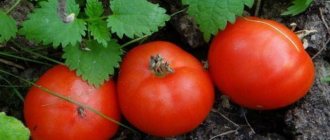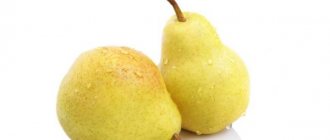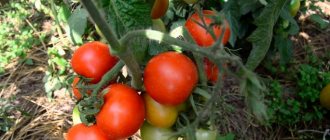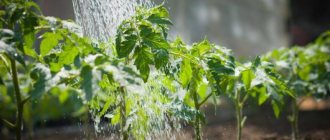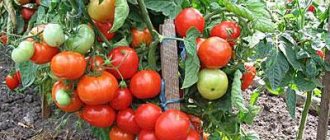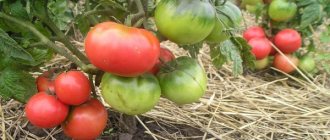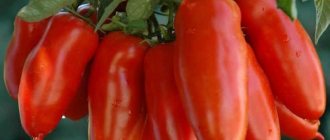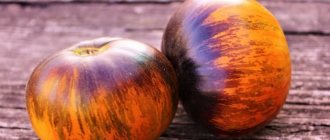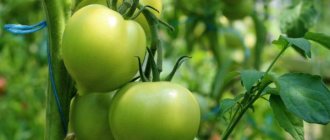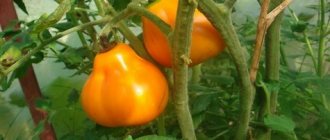» Vegetable growing » Tomatoes » Tomato variety Paradise Pleasure
0
2061
Article rating
The Paradise Delight tomato is ideal for those who love large fruits. This is a record holder for productivity. It is disease resistant and does not require special care. Compliance with the simplest rules of agricultural technology allows everyone to be convinced that their taste truly resembles the fruits of Eden.
- Advantages
- Landing Features
- Growing seedlings
- Transplant timing
- Care
- Pest Control
- Reviews
Tomato variety Paradise Pleasure
Description of fruits
Tomatoes are classified as a salad type, but the juice also has a pleasant taste. Fruit characteristics:
- The tomatoes are round in shape, but slightly flattened, with lush folds near the stalk;
- weight from 400 to 450 g, and if agronomic conditions are met, the fruits can grow up to 700–800 g;
- unripe tomatoes are green in color, the stalk has a darker color, ripe tomatoes are red in color;
- Paradise Pleasure tomatoes are characterized by juicy pulp with numerous seed chambers;
- the fruits are well preserved and do not crack;
- The seeds in the chambers are small, in small quantities, containing from 5.5 to 6.2% dry matter;
Description from photos and reviews from gardeners of the Paradise Pleasure tomato: a sweet variety, with a dense peel and strong ribbing.
The variety is rich in vitamin C: from 17.3 to 18.2 mg. It also contains sugar in amounts from 3 to 3.6%. Acidity is low: less than 0.5%.
Nuances for open ground and greenhouse conditions
Greenhouse plants are much taller than their outdoor brothers. They need to limit their growth by pinching the top of their head. If growth is not stopped, beneficial substances will be spent on unnecessary branches.
The highest rates of fruiting were noted in the southern regions. In areas with a cold climate, the crop not only grows and develops more slowly than in the south, but the quantitative indicator is also significantly reduced. However, there are many who want to grow this particular type of tomato in the northern regions. The crop, planted in well-heated closed structures, adapts to greenhouse conditions and produces sufficient offspring.
When growing tomatoes for sale, 4 tomatoes are left on the fruiting branches. This technique promotes the formation of larger vegetables. When all formed tomatoes are left on the bunch, they grow smaller in size and weight.
Characteristics of tomato
The tomato variety is classified as mid-season. It is allowed to grow the crop in open ground under favorable conditions and in equipped greenhouses.
Productivity and fruiting
The first tomatoes are picked 106–120 days after the appearance of the first shoots. From 1 sq. m, 10–11 kg of fruits are collected.
Important! Forming a tomato into one stem if it is planted in a greenhouse, or into two when the tomatoes are placed in open ground helps increase productivity.
Area of application of fruits
According to reviews, the tomato variety Paradise Pleasure is cultivated for preservation and fresh consumption. Juices, dressings and ketchups are made from it. The variety can also be used for sale: the tomato can withstand long-term transportation without damaging its appearance.
Resistance to diseases and pests
Tomato Paradise Pleasure is a variety that is immune to the tobacco mosaic virus and cladosporiosis. Bacterial spotting is not detected on it either.
Alternaria blight is not dangerous for tomatoes if you follow the care rules. When affected by a fungal disease, yellow spots appear on the leaf blades, which are gradually covered with a black coating. The fruits change color to dark brown and become depressed. Without preventive work, there is a high risk of late blight appearing on the variety: the leaf blades are covered in a white fluffy coating, the fruits are deformed and covered with spots.
Advantages and disadvantages of the variety
When choosing a culture, it is recommended to study it from all sides. According to reviews, the Paradise Pleasure tomato has one of the main advantages - it is high yield and the ability to grow it in equipped premises and in open ground.
Advantages of tomatoes of this variety:
- large-fruited: the fruits ripen gradually, the pulp is sweet and uniform;
- the possibility of long-term storage of the variety and its transportation without loss of presentation and taste;
- resistance to pests.
One of the disadvantages of Paradise Pleasure is the need to follow the rules of care: tying, watering and circumcising the stepsons.
Picking seedlings
Planting of seedlings is carried out a month later, after sowing the grains in the ground. With proper cultivation and care, by this time two true leaves should already appear on the plants.
- The seedling is cut at soil level.
- The cut sprout is placed in a plastic cup with warm water for 20 minutes.
- The seedlings are planted in the soil and covered with a film cap.
- After 2 days, the plants are placed in a bright room and the hardening stage begins.
Important! It is better to plant plants in peat soil or specialized soil. It is strictly not recommended to add humus to the soil, as it will contribute to the development of root rot. The root system of seedlings is cut off in order to prevent the risk of transferring infection from one container to another
Thanks to this technique, plants get sick less and grow as healthy as possible.
The root system of seedlings is pruned in order to prevent the risk of transferring infection from one container to another. Thanks to this technique, plants get sick less and grow as healthy as possible.
Growing rules
Tomato Paradise Pleasure is recommended to be grown in seedlings. It is impossible to collect seed stock from fruits, so it must be purchased annually.
Planting seedlings
The optimal time to start growing tomato varieties is the end of February or the first half of March.
Growing tomatoes requires preliminary preparation: it is recommended to buy seeds from trusted producers. The raw materials must be undamaged and dry. The seeds are treated with a solution of potassium permanganate or placed in Fitosporin for 10–12 hours.
Important! Some manufacturers process the raw materials themselves, so colored seeds do not need to be prepared for planting.
The tomato variety Paradise Pleasure is grown for seedlings using a certain type of soil. To do this, mix peat and sand in a 1:1 ratio. Enrich the finished mixture with 30 g of superphosphate and potassium sulfate.
The seeds are transferred to a cotton cloth and left in a solution of wood ash for 2–3, after which they are disinfected in Epin liquid for 24 hours. For the next 6 hours, the raw materials are kept in the refrigerator.
Containers (peat pots or containers with sections) are filled with soil and spilled with hot water. Using a stick, make depressions up to 3 cm in the soil and place seeds in them, which are sprinkled with earth on top.
The container is covered with film and transferred to a warm room with good lighting until sprouts appear. Next, the tomatoes are periodically taken outside for hardening in sunny weather for 10–15 minutes.
Caring for seedlings of this variety involves timely watering: the soil is treated with a spray bottle of warm water as it dries. When two true leaves appear, the seedlings are plucked if necessary: they are separated from a common container into peat pots so that the root system is strengthened and the tomato is not crowded.
Important! If it is necessary to grow a crop outside a greenhouse, it is recommended to use seedlings planted at the end of March: by the time they are transferred to the soil, they reach optimal size.
Tomato transplant
The period for transferring tomatoes to open ground is the end of April or the beginning of May, when the weather is sunny and the soil has warmed up. The crop is planted in the greenhouse when the soil has warmed up to +15 °C, and indoors at least +25 °C.
The open ground is dug up and organic fertilizers are applied 14 days before transplanting the tomatoes, after which the beds are formed. For 1 sq.m. It is recommended to plant no more than 2 plants according to the 70×60 scheme.
Dig a hole in the soil, then pour in a little water, transfer the tomato with a lump of earth into the hole and sprinkle it with soil. At the end of the work, it is recommended to cover the tomatoes of the Paradise Pleasure variety with compost and moisten them well.
Subsequent care for tomatoes
The basic principles of caring for Paradise Pleasure are no different from other varieties, but due to the high yield of the crop, additional fertilizing is required.
The first fertilizer is applied during planting or after 15–20 days. They use minerals as fertilizers or use specialized formulations for nightshade crops.
The Paradise Pleasure variety requires a mandatory garter, so it is recommended to use wooden pegs or metal structures to create support. The tomato is tied in several places so that it is in an upright position.
The stepsons under the first brush are removed, and after the appearance of the third brush, pinching is carried out from 3–4. When cultivating tomatoes for sale, it is recommended to save 4 Paradise Delight tomatoes for 2 and 3 clusters: they will all be large. Up to 6 fruits are left for personal needs; they grow smaller in size and weight.
It is necessary to moisten the soil 1–2 times a week; combine watering with fertilizing during fruit formation. It is recommended to use warm water and avoid getting liquid on the leaf plates. After moistening the soil, it is necessary to loosen the tomatoes, remove dried parts and damaged fruits.
Landing Features
Due to the late ripening period, it is recommended to grow tomatoes only in seedlings (even in warm regions).
It is customary to start sowing seeds at the beginning of March, but if it is possible to provide high-quality, full-fledged lighting, then they begin at the end of February.
The second option is suitable only for those who have a greenhouse, where they can transplant seedlings in May without fear of frost or drastic changes in weather conditions.
Growing seedlings
Many people try to quickly grow seedlings, not thinking that flowering tomatoes in frozen ground, if they do not die, will suffer significant developmental delays.
The Paradise tomato seedlings should get stronger.
When real large leaves appear, additional feeding can be used. Mineral fertilizers and vermicompost are suitable in proportions corresponding to the container with seedlings.
It would be useful to prepare trellises and stakes in advance, which will provide the plants with fixation. This is especially true for bushes grown in open ground. There they are not protected from powerful gusts of wind and heavy rains.
Pest and disease control
Despite its resistance to most diseases, the Paradise Pleasure variety is susceptible to the development of late blight: the bushes are very powerful and spreading, preventing the evaporation of excess moisture from the soil.
In rainy seasons, as a disease prevention, it is necessary to treat tomatoes with Fitosporin or Ecosil according to the instructions.
If late blight is detected on a tomato, the damaged leaf blades are immediately removed, whole fruits are picked and left to ripen indoors. If it is impossible to preserve the plant, it is removed, and neighboring bushes are treated for prevention.
For Alternaria blight, treatment is carried out within 3–7 days from the appearance of the first signs: the tomato is completely restored. The variety is treated with fungicides Antrakol 70 WG, Infinity or Flint.
To prevent Alternaria blight, it is necessary to feed the plant in a timely manner, avoid getting water on the leaf blades and treat the tomatoes with Trichodermin.
How to care
Since the plant is powerful, it requires a lot of attention, you will have to:
- regular and abundant soil moisture;
- frequent feeding;
- tying hands;
removing excess leaves; annual pruning of branches after harvesting to stimulate the growth of new fruit-bearing shoots; rejuvenating pruning of an adult plant in spring.
The plant produces a lot of lashes, so trellises are installed to support them. Many gardeners weld structures (net trellises) from rods and tie the crown of a tree to them, like grapes.
The crop is propagated by vegetative methods. To do this, cut cuttings from a 1-2 year old plant with a diameter of 1 cm and a length of up to 50 cm. In the spring, they are placed in water to form roots, then planted in the ground. The grown cuttings will bear fruit in the first year of life. A large number of seedlings can be prepared from cuttings. Cuttings cut in the fall after the formation of roots can be planted in pots and monitor the development of the bushes in your home all winter. The strongest sprouts, 15-30 cm high, with 5-7 leaves, are planted in open ground. They are planted at a distance of 1.5 - 2 m. If there is no trellis, then stakes up to 2 meters high are driven in to support the bush when planting nearby. To prevent diseases, the roots of the plant are treated with water with iodine: for 1 bucket of water - 1 bottle of iodine from the pharmacy.
